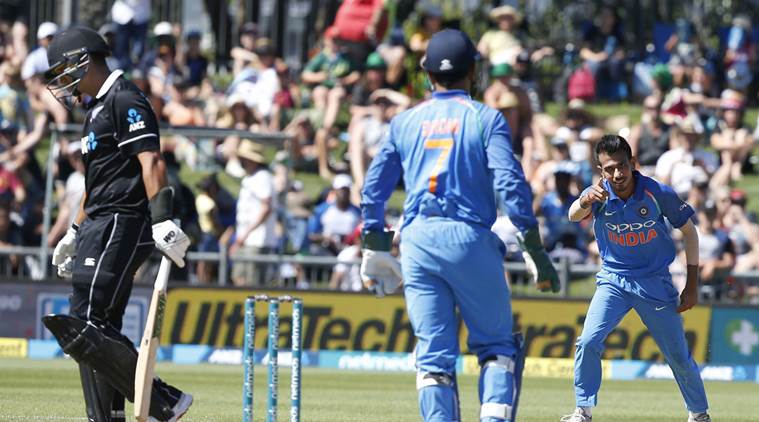
“To play two wrist-spinners,” Virat Kohli remarked before the ODI series against New Zealand in October 2017, “is a big temptation.” He then succinctly reminded of the status quo: “We thought both Ashwin and Jadeja needed a breather.” At that point in time he made perfect sense, hardly sounding like a skipper caught in a perceptional time warp in his steadfastness to an orthodox off-spin-left-arm spin combo, the usual stifler-aggressor jugglery rather than embracing a more radical leg-spin-chinaman pair.
For those were days when he needn’t have looked beyond Ravichandran Ashwin and Ravindra Jadeja in both Tests and ODIs. Though both Yuzvendra Chahal and Kuldeep Yadav had offered a peek into their collective abilities in the ODIs against Australia, it was still preposterous to think of them usurping Jadeja and Ashwin in the immediate future. Their absence was considered short-term, a chance for keeping the second-line ready, an emergency alternative.
But 14 months later, Chahal and Yadav have not only emerged as India’s undisputed frontline spinners but also thrilled the cricketing world with their double acts. So much so that irrespective of the climes and conditions, both Chahal and Yadav have become indispensable. The numbers they have racked up are mind boggling — in 24 matches, they’ve picked up 93 wickets at just a shade over 22, conceding less than five runs an over, which’s the gold standard in ODI cricket these days. Six of their wickets came on Wednesday, which underlined India’s eight-wicket victory against New Zealand in the series opener.
It’s the rarest of bowling combinations —a mirror image rather — but when you break their craft down to the fundamentals, it’s more like playing a leg-spinner and off-spinner together. Chahal essentially spins the ball away from the right-handed batsmen, while Yadav brings the delivery into him. Their wrong’un turn opposite ways, even the flippers are different.
Yadav’s turns away a shade, while Chahal’s comes in a trifle. Yadav compulsively flights the ball, Chahal less so. The only commonality is that they use wrist than fingers — the same reason that had stood against them in featuring more regularly. But by the same logic, Ashwin and Jadeja are an odd pair, as both are finger spinners. And it’s unlike the Shane Warne-Stuart MacGill quandary, when both plied the same form, albeit with subtle differences.
Another reason that might have dissuaded Kohli is the wrist-spinners’ historical propensity to bowl loose deliveries, the odd long-hop or full toss. As much as their good days can be excellent, their bad days can be damning. Thrice in 36 matches has Yadav leaked more than 7.50 runs an over; four times has he conceded more than 6.50 runs. Chahal was once smashed around for 68 runs in 5.3 overs, by South African batsmen in Johannesburg. A more economically reliable option, thus, is Ravindra Jadeja, who can tie an end up with his precision. A reason Kohli opted for a Jadeja-Yadav/Chahal permutation in the Australia series. “A bit of dryness in the pitch and Jadeja can be quite useful,” Kohli had said. Another factor was Jadeja’s batting and fielding utilities.
Hence, Yadav partnered Jadeja in the first two while Chahal replaced him in the third. He did what he does — strangle the batsmen in the middle overs. But Kohli missed an attacking spin option from both ends.
It’s a misconception that Chahal and Yadav can’t keep a lid on the scoring. In fact, they compare favourably with Jadeja in this regard too. Both have respectful economy rates of 4.72 and 4.78. Jadeja’s is 4.89, though he has played 100 more matches than the both of them. But more than their ability to control the scoring rate, it’s their attacking potential that brings them to the forefront of India’s World Cup title reclaiming bid. They duly demonstrated that on Wednesday, on a surface that hardly yielded turn in the conventional sense.
They accomplished their job with the usual wrist-spinners’ deceit of turn, subtle variations in flight and length and second-guessing the batsman’s intentions. Like Chahal did Ross Taylor’s. He continuously teased and tormented him with drift and dip before sensing that Taylor was about to lose patience, pulled his length back for Taylor to miscue. He deceived another good player of spin, Tom Latham, with subtle change of length.
Yadav the twisted the knife through the lower middle-order, besides bargaining the most prized New Zealand wicket, Kane Williamson. Again, he was undone by the dip, forced to stretch for the delivery. The rest had little clue about him, best summed up by MS Dhoni’s advice from behind the stumps when Trent Boult was batting: “He (Trent Boult) will block the ball blindly, just bowl straight from around the stumps.”
Thus in just one innings, they managed one wicket more than what Ashwin and Jadeja had managed in five matches during India’s tour in 2013-14. Ashwin got only a wicket in the entire series, Jadeja snared four, at averages of 227 and 60 respectively, besides giving away more than five runs an over. Short boundaries and flat wickets did them in.
But both Chahal and Kuldeep were aware of the conditions.”The ground are small here. And the wicket is very flat. We just stuck to our basics,” said Kuldeep. The adaptability won them Kohli’s praise too. “The pitch got slow in the second half of the innings but in the first half the spinners bowled well, cramped the batsmen and they still made it difficult despite the dimensions on the field,” he extolled them. And it’s safe to assume that they are no longer a temptation or indulgence for Kohli, but rather an inevitability.